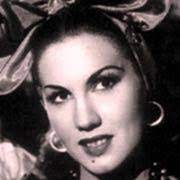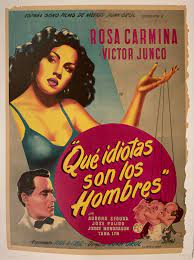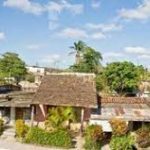ROSA CARMINA, ONE OF THE GREAT ACTRESSES IN FILMS AND TELEVISION. PHOTOS / VIDEOS
Rosa Carmina Riveron Jimenez, better known in the artistic world only as Rosa Carmina was born in Havana, Cuba on November 19, 1929, and has been a film and television actress, singer, dancer, and Vedette. She represented the erotic dreams of several generations of Latin American music and action film fans. She is a legendary film actress considered the first figure of the so-called Cine de Rumberas of the well-known Golden Age of Mexican cinema.
She was also known during many years of an artistic life as: “The Woman of Fire”, “The Queen of the Gangsters” and “Her Majesty of her La Rumba”. President Miguel Alemán nationalizes her by Mexican nationality shortly after she settled in the country. She arrives in Mexico from the hand of the Spanish producer and director Juan Orol.
Her great beauty and her height of 1.77 m made her stand out in a particular way, since at that time she was a rare physical characteristic in female stars, giving everyone an imposing presence of her.
ARTISTIC LIFE
She begins her artistic career starring in the film A Woman from the Orient (1946). She was a fundamental part of Orol’s film team for several years in their best gangster films or black cinema of the 1940s and 1950s. Other production companies also required her, including Clasa World Films and Rosas Priego Productions, which becomes your exclusive artist.
https://youtu.be/SWmbSDOnUP4
ROSA CARMINA DANCING (VIDEOS)
She achieves great popularity thanks to her temperament and bearing, but above all, because of her imposing presence and unusual statue of her in the stars of the time, which made her stand out from the rest of the “rumberas”. The journalist and filmmaker Manuel Ávila Camacho renamed it “Her Majesty the Rumba” because according to the writer, the actress and star is the most impressive artistic presence that Cuba has given.
She has starred in films made in Latin American and European locations produced by the companies Spain Sono Films, Juan Orol, Hispano Continental Films, chaired by Miguel Contreras Torres, García Bené producciones, as well as the IFI film company, owned by the prolific Catalan producer Ignacio F. Iquino.
Her artistic career is very wide both in the cinema, as in the theater, and in massive shows in which she has performed live. He has participated in numerous film productions such as Viajera (1951), En Carne viva (1952), and above all, Sandra, la Mujer de Fuego (1954), and its sequel The Crime Syndicate (1955), which are considered classics of both cinemas. rumberas and gangster movies, both shot in Cuba.
As the entrepreneur of her own shows, she is a pioneer, performing live both in bullrings and in stadiums throughout the American continent, where she has achieved major successes at a time when television was not yet considered a mass medium. Communication. Pantaleón and the Visitors are considered one of the last relevant appearances of her in the cinema. In the 80s and 90s, she acted in some soap operas, the last being María Mercedes (1992), along with Thalía.
PERSONAL LIFE
Rosa Carmina has been married several times.
Her first husband, Francisco Morales Llanes, was a military man and head of intelligence in Cuba during World War II. She later married the controversial Spanish film producer and director Juan Orol. Her third husband was Ramón de Flórez, (responsible Spanish businessman, together with the famous decorator Arturo Pani, brother of the renowned architect Mario Pani, of the emblematic Villa Fontana restaurant, as well as the famous Villafontana Violins). Rosa Carmina joined entrepreneurs of Spanish and Lebanese origin respectively. For some years now, she has been living in Barcelona, Spain.
She currently lives retired and surrounded by great luxury in one of the most emblematic areas of Barcelona.
FILMOGRAPHY
Selection and last of her films
Story of an Unfaithful Husband (1956)
Love me with music (1956)
Unforgettable melodies (1958)
My wife needs a husband (1958)
Who are our crazy people with (1959)
Tragic Cabaret (1959)
My Private Secretaries (1960)
The Last Fight (1960)
The infernal face (1961)
The mystery of the cobra (1961)
How much is your son worth? (1961)
The macabre footprint (1962)
The White Shadow (1962)
Mexico at night (1973)
Beauties at night (1974)
Pantaleón and the Visitors (1974)
Trail of Death (1981)
Follies Theater (1982)
This one and the other with a single ticket (1983)
Isabela’s Passion (1984)
Juana Iris (1985)
Girl (1986)
Simply Maria (1989)
Die to Live (1989)
The Marked Hour (1990)
Maria Mercedes (1992)
AWARDS AND TRIBUTES
She has been the subject of numerous tributes, both in Mexico and abroad. It is worth highlighting those that were offered to her both at the Cinematheque in Paris, at the George Pompidou Center in the same city, and at the Festival of the Three Continents in Nantes, France, where she achieved a formidable success according to the French press when he performed live with her show “Rumba, poetry, and the song”, as well as in several universities and museums in Germany where her films and costumes have been exhibited in exhibitions organized by the writer and film critic Fernando Muñoz Castillo.
ROSA CARMINA, UNA DE LAS GRANDES ACTRICES DEL CINE Y LA TELEVISION. PHOTOS/ VIDEOS
Rosa Carmina Riveron Jimenez, mas conocido en el mundo artistico solo como Rosa Carmina nacio en la Habana, Cuba el 19 de Noviembre de 1929 y ha sido Actriz del cine y la Televisión, Cantante, Bailarina y Vedette. Representó los sueños eróticos de varias generaciones de latinoamericanos aficionados al cine musical y de acción. Es una legendaria actriz cinematográfica considerada primera figura del llamado Cine de Rumberas de la conocida Época de oro del cine mexicano.
Fue conocida tambien durante muchos años de vida artistica como: “La Mujer de Fuego”, “La Reina de los Gansteres” y “Su Majestad La Rumba”. El Presidente Miguel Alemán la nacionaliza mexicana al poco tiempo de haberse instalado en el país. Llega a México de la mano del productor y director español Juan Orol.
Su gran belleza y estatura de 1.77 m la hizo destacar de una manera particular, ya que en esa época era una característica física poco frecuente en las estrellas femeninas, proporcionándole una imponente presencia.
https://youtu.be/-vijpY0DXdM
LA HISTORIA DE ROSA CARMINA (VIDEOS)
VIDA ARTISTICA
Inicia su carrera artística protagonizando la película Una mujer de oriente (1946). Formó parte fundamental durante varios años del equipo fílmico de Orol en sus mejores filmes del cine de gángsters o cine negro de las décadas de los 40 y 50. Otras productoras también la requirieron, entre éstas: Clasa Films Mundiales y Producciones Rosas Priego de la que llega a ser su artista exclusiva.
Alcanza gran popularidad gracias a su temperamento y porte, pero sobre todo, por su imponente presencia y estatura poco frecuente en las estrellas de la época, que la hizo destacar del resto de las “rumberas”. El periodista y cineasta Manuel Ávila Camacho la rebautizó con el sobrenombre de “Su Majestad la Rumba”, pues según el escritor, la actriz y vedette es la más impactante presencia artística que ha dado Cuba.
Ha protagonizado filmes realizados en locaciones latinoamericanas y europeas bajo la producción de las empresas España Sono Films, Juan Orol, Hispano Continental Films, presidida por Miguel Contreras Torres, García Bené producciones, así como de la compañía cinematográfica IFI, propiedad del prolífico productor catalán Ignacio F. Iquino.
Su carrera artística es muy amplia tanto en el cine, como en el teatro y en espectáculos masivos en los que se ha presentado en vivo. Ha participado en numerosas producciones fílmicas tales como Viajera (1951), En carne viva (1952) y sobre todo, Sandra, la mujer de fuego (1954) y su secuela El sindicato del crimen (1955), que son consideradas clásicos tanto del cine de rumberas como del cine de gángsters, ambas rodadas en Cuba.
https://youtu.be/r7-N-Ei5EYo
ROSA CARMINA FILMES (VIDEOS)
Como empresaria de sus propios espectáculos, es pionera, al presentarse en directo tanto en plazas de toros, como en estadios a lo largo del continente americano en los que ha alcanzado importantes éxitos en una época en que la televisión todavía no era considerada un medio masivo de comunicación. Pantaleón y las visitadoras es considerada una de sus últimas apariciones relevantes en el cine. En las décadas de los 80 y 90 actuó en algunas telenovelas, siendo la última María Mercedes (1992), junto a Thalía.
PERSONAL LIFE
Rosa Carmina ha estado casado en varias ocasiones.
Su primer marido, Francisco Morales Llanes, fue un militar y máximo responsable de la inteligencia en Cuba durante la Segunda Guerra Mundial. Después contrajo nupcias con el polémico productor y director de cine español Juan Orol. Su tercer marido fue Ramón de Flórez, (empresario español responsable, junto con el célebre decorador Arturo Pani, hermano del reconocido arquitecto Mario Pani, del emblemático restaurante Villa Fontana, así como de los célebres Violines de Villafontana). Rosa Carmina se unió a empresarios de origen español y libanés respectivamente. Desde hace algunos años, radica en Barcelona, España.
Actualmente vive retirada y rodeada de gran lujo en una de las zonas más emblemáticas de Barcelona.
FILMOGRAFIA
Seleccion y ultimas de sus peliculas
Historia de un marido Infiel (1956)
Quiéreme con música (1956)
Melodías inolvidables (1958)
Mi mujer necesita marido (1958)
Con quien andan nuestros locos (1959)
Cabaret trágico (1959)
Mis secretarias privadas (1960)
La última lucha (1960)
El rostro infernal (1961)
El misterio de la cobra (1961)
¿Cuánto vale tu hijo? (1961)
La huella macabra (1962)
La sombra blanca (1962)
México de noche (1973)
Bellas de noche (1974)
Pantaleón y las visitadoras (1974)
Rastro de muerte (1981)
Teatro Follies (1982)
Esta y l’otra con un solo boleto (1983)
La pasión de Isabela (1984)
Juana Iris (1985)
Muchachita (1986)
Simplemente María (1989)
Morir para vivir (1989)
La hora marcada (1990)
María Mercedes (1992)
PREMIOS Y HOMENAJES
Ha sido objeto de numerosos homenajes, tanto en México, como en el extranjero. Caben destacar los que le ofrecieron tanto en la Cinemateca de París, como en el Centro George Pompidou de la misma ciudad y en el Festival de los Tres Continentes en Nantes, Francia, donde consiguió un éxito formidable según la prensa gala al presentarse en directo con su espectáculo “Rumba, poesía y canto”, así como en varias universidades y museos de Alemania en donde se han exhibido sus películas y vestuario en exposiciones organizadas por el escritor y crítico de cine Fernando Muñoz Castillo.
Agencies/ Wiki/ Ecured/ Internet Photos/ YouTube/ Arnoldo Varona/ www.TheCubanHistory.com
THE CUBAN HISTORY, HOLLYWOOD.



























